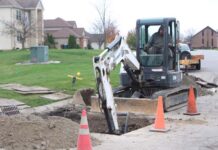Mayor Whicker asks Street Commissioner to discuss city codes; no action taken
By DAVE SCHULTZ
Bluffton Mayor John Whicker on Tuesday night addressed a concern expressed to him by “a longtime resident” who lives in the 200 block of West Wabash Street. The nature of the concern: Truck traffic in the city.
While it is true that several streets are obviously not intended for semi tractor trailers and similar heavy vehicles, it is also true that sometimes those streets must be used by those vehicles to supply city businesses, whether they be industrial or retail facilities.
To reinforce the point, Whicker asked Street Commissioner Tim Simpson, the man most familiar with the city’s thoroughfares, to discuss city codes with the members of the Bluffton Council. He focused on what’s allowed and what’s not allowed.
Simpson prefaced his remarks by noting that years ago, Wabash Street between Bond Street and Ind. 1/Main Street was designated as Ind. 124. The state highway has since been re-routed north across the Gerber Bridge and joins Ind. 116 on the west side of Bluffton, coming into the city on West Dustman Road. Both highways then join Ind. 1 on Main Street and come through the middle of the city. Ind. 124 turns east just north of the Wabash River and Ind. 116 turns east just north of the Harrison Plaza, while Ind. 1 continues south.
It was noted during the discussion that none of the officially-designated state highways in Bluffton allow curbside parking.
It makes sense that trucks are not allowed on the often-narrow streets in the city, and there was a push not long after Whicker took office to ban parking on one side of the street, particularly in residential areas. Fire Chief Don Craig often took the point on those discussions, saying that fire trucks can’t get to where they’re needed — and at least once, a fire truck hit a parked car en route to a 911 call. Parking was banned on one side of a few streets in town in 2020 to ease that problem.
Addressing the matter Whicker brought up Tuesday night, Simpson read from the city code about truck restrictions. Then he noted the exceptions — the delivery or picking up goods or property. Even then, the trucks are supposed to take the shortest way possible or as otherwise directed by a police officer.
Those exceptions can be wide-ranging, Simpson said.
“That pretty much includes every street in town when you look at the location of our businesses,” he said, noting Almco Steel on North Oak Street and the recycling center between Markle and Wabash streets on the west side of town as two examples. “With the growth (in business), we see an increase in truck traffic,” he said.
Another problem is detours. Global Positioning Systems, usually referred to by the initials GPS, will automatically suggest alternative routes for vehicles. Those alternatives may or may not take notice of designated truck routes.
When truck drivers get stuck on a narrow residential street, Simpson said, they’ll hold up a smartphone as a way of explanation: “My phone brought me here,” the driver will say.
There’s no way around it, Simpson said. “We have it in our code. They have a right to delivery.”
Simpson also looked ahead a few days. “When the Street Fair hits, Wabash Street is the designated detour route.”
Simpson noted that the city installed Americans With Disabilities Act sidewalks and corners on the west side along Wabash Street. “The were setting for two hours before a truck ran over it,” he said. There have been problems at the intersection of Washington Street and Ind. 1/Main Street, as the traffic signal has been hit three times recently which forced the Indiana Department of Transportation to replace it.
Council President Scott Mentzer asked Simpson Tuesday night if he had any recommendations. Simpson said he was there to explain the situation at Whicker’s request, and he had no recommendations.
The council took no action on the matter.
daves@news-banner.com



